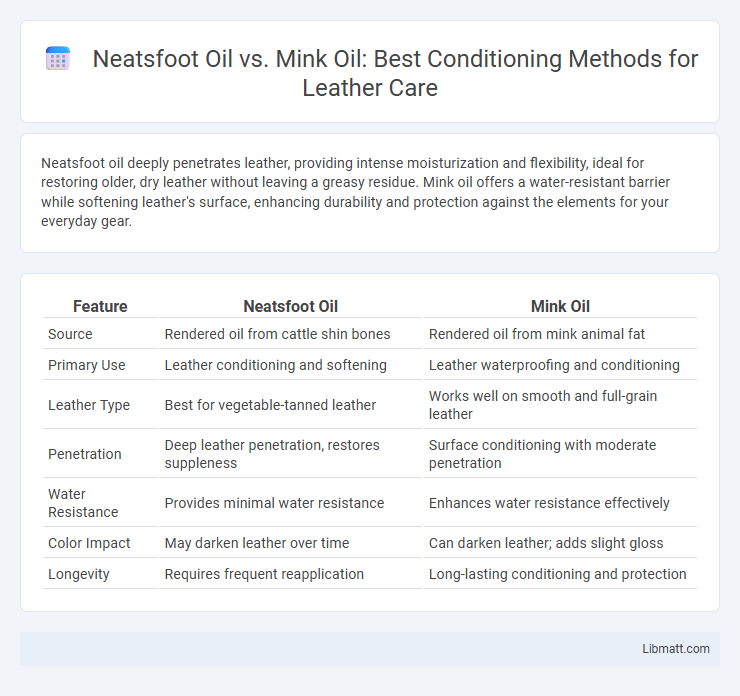Neatsfoot oil deeply penetrates leather, providing intense moisturization and flexibility, ideal for restoring older, dry leather without leaving a greasy residue. Mink oil offers a water-resistant barrier while softening leather's surface, enhancing durability and protection against the elements for your everyday gear.
Table of Comparison
| Feature | Neatsfoot Oil | Mink Oil |
|---|---|---|
| Source | Rendered oil from cattle shin bones | Rendered oil from mink animal fat |
| Primary Use | Leather conditioning and softening | Leather waterproofing and conditioning |
| Leather Type | Best for vegetable-tanned leather | Works well on smooth and full-grain leather |
| Penetration | Deep leather penetration, restores suppleness | Surface conditioning with moderate penetration |
| Water Resistance | Provides minimal water resistance | Enhances water resistance effectively |
| Color Impact | May darken leather over time | Can darken leather; adds slight gloss |
| Longevity | Requires frequent reapplication | Long-lasting conditioning and protection |
Understanding Neatsfoot Oil: Composition and Benefits
Neatsfoot oil, derived from the rendered shin bones and feet of cattle, is rich in natural fats that deeply penetrate leather fibers to restore suppleness and prevent cracking. Unlike mink oil, which contains lanolin and enhances water resistance, Neatsfoot oil excels in maintaining your leather's flexibility without darkening its color significantly. Its unique composition makes it an ideal conditioner for preserving soft, durable leather goods through regular application.
What is Mink Oil? Key Properties and Uses
Mink oil is a natural oil extracted from the fatty layer beneath the skin of minks, prized for its excellent moisturizing and conditioning properties. Rich in palmitoleic acid, mink oil deeply penetrates leather to restore suppleness, enhance water resistance, and prevent cracking. It is commonly used for conditioning high-quality leather goods, including boots, gloves, and saddles, to maintain durability and flexibility.
Historical Use: Neatsfoot Oil vs Mink Oil
Neatsfoot oil has been historically favored by leatherworkers and saddlers since the 18th century for its effective conditioning and softening properties that preserve leather durability. Mink oil, derived from the fat of minks, gained popularity in the early 20th century for its water-resistant qualities and ability to restore suppleness to leather goods exposed to harsh conditions. Choosing between Neatsfoot oil and mink oil depends on whether Your priority is long-established leather nourishment or enhanced moisture protection.
Leather Conditioning: Effectiveness Compared
Neatsfoot oil deeply penetrates leather fibers, providing excellent conditioning and restoring natural suppleness without causing excessive darkening or surface damage. Mink oil offers superior waterproofing and surface protection due to its high fat content, but can sometimes darken leather more noticeably and create a slightly tacky finish. For long-term leather health, neatsfoot oil is often preferred for softening and maintaining flexibility, while mink oil is favored for enhancing water resistance and durability.
Moisturizing Power: Which Oil Performs Better?
Neatsfoot oil offers exceptional moisturizing power by deeply penetrating leather fibers, restoring flexibility and preventing cracking over time. Mink oil excels at creating a water-resistant barrier while providing moderate hydration, making it ideal for lighter conditioning needs. For intensive leather restoration, neatsfoot oil outperforms mink oil in maintaining softness and durability.
Long-term Impact on Leather Durability
Neatsfoot oil penetrates deeply into leather fibers, providing lasting moisture that helps prevent cracking and maintains flexibility over time. Mink oil, rich in natural fats, offers excellent waterproofing and enhances leather's suppleness but can darken the leather and potentially soften it excessively with prolonged use. For long-term durability, your choice depends on whether you prioritize deep conditioning and preservation (Neatsfoot oil) or enhanced water resistance and a softer feel (mink oil).
Application Methods: Tips and Best Practices
Neatsfoot oil is best applied with a clean cloth or sponge, gently massaging it into leather to ensure deep conditioning without oversaturation. Mink oil benefits from light application using a soft brush or cloth, allowing it to penetrate and provide water resistance while enhancing leather flexibility. For optimal results, test products on a small area of your leather item to avoid discoloration and maintain its natural texture.
Potential Risks: Staining, Darkening, and Odor
Neatsfoot oil can cause leather to darken significantly and may lead to staining on lighter-colored items, with a potential strong, animal-like odor that some users find unpleasant. Mink oil also darkens leather but typically less intensely than neatsfoot oil, while offering a milder scent; however, both oils carry a risk of residue buildup that can attract dirt or cause stickiness. Users should test on inconspicuous areas before application to prevent unwanted discoloration and strong odors on delicate or light-toned leather goods.
Eco-Friendliness and Ethical Considerations
Neatsfoot oil is derived from rendered cattle bones and hooves, making it a natural but less eco-friendly option due to livestock farming's environmental impact. Mink oil, sourced from the fat of minks, raises significant ethical concerns related to animal welfare and fur farming practices. Your choice between these conditioning oils should consider both environmental sustainability and the ethical implications of animal-derived products.
Choosing the Right Oil for Your Leather Needs
Neatsfoot oil penetrates deeply to soften and preserve vegetable-tanned leather, making it ideal for restoring flexibility without darkening the material significantly. Mink oil offers superior waterproofing and adds a subtle dark shine, suitable for smooth leather items exposed to moisture. Selecting between Neatsfoot and mink oil depends on the leather type and desired finish, balancing conditioning intensity and protective qualities.
Neatsfoot oil vs mink oil conditioning Infographic

 libmatt.com
libmatt.com